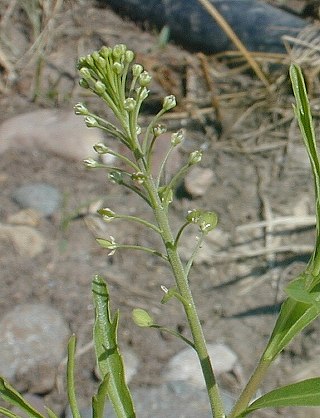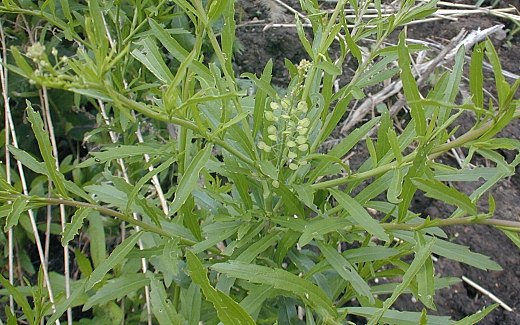Description:
This plant is a winter annual, spring annual, or biennial. It is
initially a low-growing rosette with pinnatifid leaves up to 3" long.
Later, the stems bolt upward, branching occasionally to frequently, and
the plant becomes about ¾-1½' tall. When fully developed, it frequently
has a bushy appearance, particularly in the absence of much
competition. The cauline leaves are up to 3½" long and ¾" across, and
usually oblanceolate or obovate. They are sessile at the base
(appearing to have winged petioles), and the larger leaves have a few
coarse
teeth toward their tips. The stems are green or slightly reddish pink,
and are covered with fine white hairs that are very short. The upper
stems terminate in cylindrical racemes about 2-4" long that have small
white flowers. Each flower has 4 white petals and 4 green sepals, and
is less than 1/8" (3 mm.) across. A typical raceme will have a few
flowers in
bloom at the top, while below they have been replaced by seedpods about
1/8" (3 mm.) in length at varying stages of maturity. Each flattened
seedpod has a
round oval shape with a small notch at the tip. Various plants can be
in bloom anytime from late spring to fall, peaking during early summer.
The flowers have no noticeable scent. The individual seedpods can be
carried a short distance by the wind, while on other occasions an
entire raceme of mature seedpods will become detached from the mother
plant and tumble away in the wind. The root system consists of a
slender, branching taproot.
leaves are up to 3½" long and ¾" across, and
usually oblanceolate or obovate. They are sessile at the base
(appearing to have winged petioles), and the larger leaves have a few
coarse
teeth toward their tips. The stems are green or slightly reddish pink,
and are covered with fine white hairs that are very short. The upper
stems terminate in cylindrical racemes about 2-4" long that have small
white flowers. Each flower has 4 white petals and 4 green sepals, and
is less than 1/8" (3 mm.) across. A typical raceme will have a few
flowers in
bloom at the top, while below they have been replaced by seedpods about
1/8" (3 mm.) in length at varying stages of maturity. Each flattened
seedpod has a
round oval shape with a small notch at the tip. Various plants can be
in bloom anytime from late spring to fall, peaking during early summer.
The flowers have no noticeable scent. The individual seedpods can be
carried a short distance by the wind, while on other occasions an
entire raceme of mature seedpods will become detached from the mother
plant and tumble away in the wind. The root system consists of a
slender, branching taproot.
Cultivation:
The preference is full or partial sun and moist to dry conditions. The
soil can contain loam, gravel, or clay, and range from sterile to
highly fertile. The lower leaves may turn yellow and wither away during
a drought, but this is normal. This weedy plant reseeds itself readily
and can spread to undesirable locations.
Range & Habitat:
The native Common Peppergrass is very common and it occurs in every
county of Illinois (see Distribution
Map). This plant can be found occasionally in disturbed areas
of
prairies. However, it is more common in developed areas, including
fields, pastures, vacant lots, roadsides and railroads, lawns and
gardens, gravelly junkyards, and waste areas.
Faunal
Associations: The tiny flowers
appear to be visited primarily by Syrphid flies for nectar. Other
occasional flower visitors include little carpenter bees (Ceratina
spp.), Halictid bees, masked bees (Hylaeus spp.),
Eumenine wasps, Tachinid flies, Anthomyiid flies, and others. However,
Common Peppergrass is probably capable of self-pollination without the
assistance of these insects. The caterpillars of a few species of
butterflies and moths feed on the foliage and other parts of this
plant, including Pieris rapae (Cabbage White), Pontia
protodice (Checkered White), Eustixia pepula
(Snout Moth), and Evergestis pallidota
(Purple-Backed Cabbage Worm Moth). The peppery leaves are probably not
favored by mammalian herbivores, although rabbits and groundhogs may
consume small plants during the spring when little else is available.

Photographic
Location:
The photographs were taken on the grounds of the webmaster's apartment
in Urbana, Illinois.
Comments:
This is a native plant in a family that is dominated by introduced
plants from Eurasia. The various members of the Mustard family are
often difficult to distinguish from each other. One distinctive feature
of this species is the rounded oval shape of the small flat seedpods,
each with a tiny notch at the tip. The seedpods of similar species tend
to be shaped somewhat differently, or have a larger size. Other kinds
of mustards have long slender seedpods, called 'siliques,' with a very
different appearance. The peppery young leaves of Common Peppergrass
are edible, and they can be added to salads.